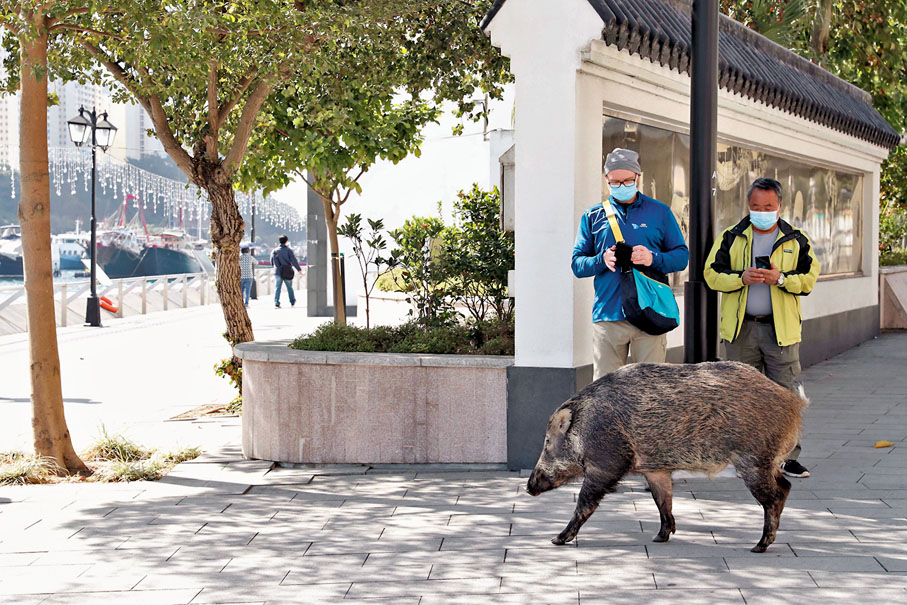【社評雙語道】野豬擾民勿輕視 堅決捕殺增巡查

【原文】11月27日晚,一頭大野豬闖入北角天后多座大廈及酒店,另有野豬在香港仔田灣咬傷外賣員。野豬傷人擾民問題發展到今天這麼嚴重的程度,是過往放任違法餵飼的惡果,政府不可輕視野豬擾民危害,要與社區基層組織多合作、多巡查,對進入市區擾民的野豬要堅決捕殺,不能因為有人反對就畏手畏腳、放任野豬擾民傷人。
本港野豬傷人個案與日俱增,今年已出現20宗,而11月更多達7宗。野豬擾民傷人問題愈演愈烈,與本港對違法餵飼野豬問題掉以輕心、放任自流有極大關係,違法餵飼野豬越來越普遍之下,本來怕人的野豬,現在根本不怕人,越來越頻繁地大搖大擺進入市區覓食。接連發生的野豬擾民、傷人個案,已對市民造成很大困擾和心理陰影,對此政府切勿輕視,應認真解決。
本港漁護署負責野生及流浪動物滋擾的監管工作,目前漁護署解決野豬問題主要有三種手段:一是以絕育方法希望控制野豬數量;二是捕殺野豬,如11月12日漁護署公布實施「滅豬行動」,定期捕捉在市區出沒的野豬及把捕獲的野豬人道毀滅;三是加強宣傳禁止餵飼野豬。這些措施也是目前世界上應對野豬問題的慣常做法,只要切實做好、做到位,是可以有效管控野豬擾民問題的。
本港實施這些措施,卻不斷遇到反對聲音,如愛護動物組織及獸醫學生以聲明或聯署形式,反對政府捕殺野豬。
野豬繁殖力強且在本港無天敵,而目前國際上對絕育控制野豬數量的成效存疑。因此,本港是否重啟野豬絕育計劃,可再觀察研究,但當務之急,是漁護署對進入市區擾民傷人的野豬,要堅決予以捕殺,決不能畏首畏尾,半途而廢。
環看世界,野豬滋擾問題已成「野豬炸彈」,如美國現有約600萬頭野豬,每年造成多達15億美元損失,歐洲多國皆出現野豬擾民問題。對待野豬滋擾,多國皆加強了捕殺野豬工作,如美國前年共人道毀滅8.4萬隻野豬。科學研究也證實,野豬並非溫馴、無破壞力動物,研究指野豬身上攜帶至少30種病毒和細菌、近40種寄生蟲,可傳給人類、寵物、野生動物,野豬有時更會直接攻擊人類。夏威夷大學一項研究顯示,野豬威脅國際自然保護聯盟瀕危物種紅色名錄中672個物種生存,覆蓋全球54個國家。因此,人類若不能採取果斷措施管控,野豬數目勢持續激增,入侵社區及破壞生態情況將愈演愈烈。
目前漁護署實施「滅豬行動」已捕捉約10頭野豬進行人道毀滅,但野豬擾民傷人個案仍在持續增加,對此漁護署「滅豬行動」要加大力度,更果斷、更堅決。另外政府正研究修訂法例,擴大野豬「禁餵區」範圍,相關立法須加快進度,同時政府要加強與各類基層組織的溝通合作,加強巡查、加大打擊違法餵飼野豬行為,切實保護市民,免受野豬滋擾傷害。 (摘錄自香港《文匯報》社評 2021-11-29)
Decisive Measures Should be Taken to Hunt Down Wild Boars Causing Nuisance
【譯文】There were reports of a wild boar intruding into a number of buildings and hotels in North Point and Tin Hau, and another one assaulting a delivery man in Tin Wan, Aberdeen. The injuries and nuisance caused by wild boars have developed into a serious issue in Hong Kong due to a lack of regulation on illegal feeding. The Government should not underestimate the harm and trouble caused by wild boars. It should work frequently with community-based grassroots organisations, conduct more patrols, and have the determination to capture and put down wild boars causing nuisance in the urban areas. It should not fear just because there are opposing views, and allow wild boars to continue to pose threats to the public.
The number of injury cases caused by wild boars in Hong Kong has continued to rise. There have been 20 such cases this year - 7 last month alone. The problem has intensified largely due to the slack enforcement of laws that prohibit feeding of wild boars. As illegal feeding becomes increasingly common, wild boars are no longer afraid of humans, and have become bold enough to forage for food in urban areas. The recent spate of wild boar incidents has caused a great nuisance and trauma to the citizens in Hong Kong. The Government must not take the problem lightly but tackle it in a serious manner.
The Agriculture, Fisheries and Conservation Department (AFCD) is responsible for the control of wild and stray animal nuisances. Currently, three major approaches are adopted by AFCD to tackle the wild boar problem. The first one is to manage the wild boar population by sterilisation; the second one is to hunt and kill wild boars, for instance, AFCD announced on 12 November 2021 that it would regularly capture wild boars in urban areas for humane dispatch; the third one is to step up publicity to educate the public not to feed wild boars. These measures are commonly adopted by countries around the world to cope with wild boar issues. As long as these measures are carried out well, it is believed that wild boar nuisance can be effectively controlled.
Nevertheless, these measures have been met with repeated criticism in Hong Kong. For example, local animal concern groups and veterinary students have objected to the killing of wild boars by issuing a joint statement and petition. Given that wild boars reproduce quickly with no natural predator in Hong Kong, and that the effectiveness of controlling wild boar population by sterilisation is questionable internationally, whether the city should resume its boar sterilisation programme is an issue to be studied and monitored. The urgent task of AFCD now is to hunt down the wild boars causing nuisance and injuries in the urban areas with determination. The Government must not fear to take actions or give up on implementing its measures.
The threat of the "feral swine bomb" has caused trouble to countries around the world. For example, the population of wild boars in the United States has currently reached about 6 million, causing the country to lose 1.5 billion US dollars per year. Wild boars have also been a recent public nuisance in different parts of Europe. To cope with the problem, countries have stepped up their catch-and-kill strategies. For instance, in 2019, 84,000 wild boars were caught and euthanised in the United States. Scientific studies have also shown that wild boars aren't gentle and non-destructive. Studies have pointed out that wild boars carry at least 30 types of virus and bacteria, and nearly 40 kinds of parasites, which are transmissible to humans, pets and wildlife animals. Wild boars also attack humans sometimes. A study conducted by the University of Hawaii System reveals that 672 species listed on the International Union for Conservation of Nature Red List of Threatened Species, inhabiting in 54 countries, are threatened by the presence of wild boars. Therefore, if human beings do not take bold and decisive measures, the population of wild boars will continue to surge, and the problem of wild boar invasion in local communities and the damage to the ecology will intensify.
Currently, 10 wild boars have been capture for human euthanasia in the operations of AFCD against the species. However, the number of reports on wild boar nuisance and attacks continues to rise. For this reason, AFCD needs to step up operations against wild boars and act more boldly and decisively. Moreover, while the Government considers amending relevant legislations to expand the feeding ban area, it should expedite the progress and strengthen its communication and cooperation with various grassroots organisations to step up patrols and efforts in combatting illegal feeding of wild boars, in order to effectively protect citizens from nuisance and harm caused by wild boars.●Kit Siu
